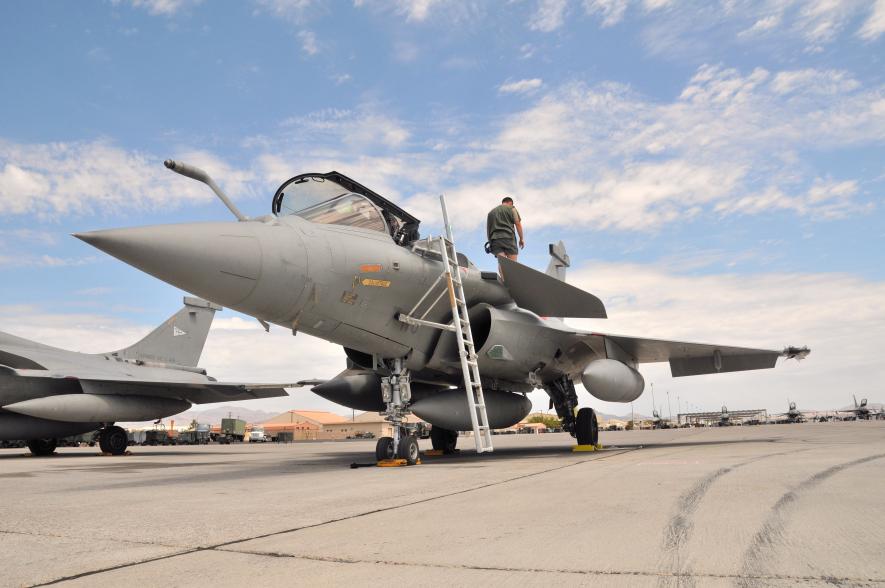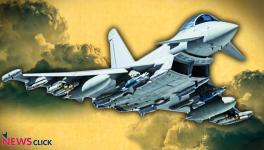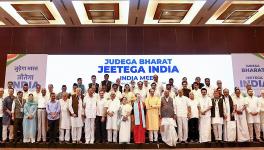New Fighter Aircraft Deal - Again?

The ink has barely dried on the acquisition of the French Rafale fighter aircraft, and India has once again entered the international arms market with the intention to procure hundreds of fighter jets, albeit with the proviso that they be manufactured in India. The Rafale deal, for outright purchase of 36 twin-engined medium-weight multi-role combat aircraft (MMRCA) worth around $ 7.8 billion (Rs.50,000 crores), did not quite turn out to be ‘the mother of all defence deals’ it was once hailed as. But that mantle has now quickly been passed on to the new expected fighter aircraft acquisition, this time of maybe around 200 light single-engined aircraft, a deal currently estimated to be worth $12-15 billion and already being labelled one of the largest defence deals ever.
India has issued letters to several manufacturers seeking their response. The voluble Defence Minister Manohar Parrikar has expressed his intention to complete the selection process in a short time, maybe even within a year.
This new turn of events raises many disturbing issues for the nation and uncomfortable questions for the government. What exactly is the vision for the admittedly urgent need for modernization and upgradation of the Indian Air Force (and other defence services), wherein one kind of fighter is considered essential one day and a completely different type declared as essential the next? Who is determining this vision and the acquisitions arising from it, the Air Force professionals, the bureaucracy or the political leadership, in this case the Raksha Mantri as he himself claims? What process is being followed and where does accountability lie for decisions taken, costs incurred and impacts on India’s defence preparedness? What direction is this acquisition likely to take and who stands to benefit from it?
Why new acquisition?
After the French Rafale was picked as winner of the MMRCA tender, beating off competition from the Eurofighter Typhoon, the prolonged price negotiations encountered one or the other hurdle such as offset percentage, terms of technology transfer, performance guarantees of the aircraft to be manufactured by the Indian partner, Hindustan Aeronautics Ltd (HAL), and price including life-cycle costs. With the deal getting mired and looking likely to collapse altogether, the NDA government abruptly announced scrapping of the original tender for 126 fighters and substituting it with outright purchase of a mere 36 fighters through a government-to-government deal. Given the lower numbers involved, the cost rose to about $240 million (Rs.1500 crores) per aircraft.
After years of careful consideration of all factors, and keeping in mind the evolving needs of the Air Force for a certain type of aircraft, a collective decision involving representatives of the Air Force, the bureaucracy and the political leadership had been taken to acquire a medium fighter aircraft also capable of carrying heavier payloads including strategic weapons. One may perhaps concede the right of the subsequent NDA government of the day to change its mind on grounds of cost. But now, the very type of aircraft has been changed, with very different capabilities and role!
It is indeed strange that India is going back to a light single-engined fighter at this point of time. The indigenous Light Combat Aircraft (LCA) has apparently, even if belatedly, finally come to maturity, has undergone extensive flight trials and top-ranking Air Force officers have testified to its capabilities as being comparable with the best in its category. The IAF has also recently ordered 140 LCAs, although induction is expected to stretch over a longer than desired period with HAL being unable to speed up deliveries.
This was anticipated even when the MMRCA tender was being drawn up, in fact that was why the earlier MCRA was amended to specify requirement for medium weight (the additional M) rather than light aircraft. As late as mid-2015, when Defence Minister Parrikar commented that the Rafale order could be scaled down without worry because the LCA would make up the gap, senior IAF officers including then Air Chief P.V.Naik disagreed sharply and publicly stating that the LCA “would have a different role and should not be confused with the requirements of a medium multi-role fighter.”
So why was this momentous new decision taken, and by what process? From all accounts, the Air Force has not been pushing for single-engine fighters, so clearly this was mostly a political decision, with Defence Minister Parrikar proudly taking credit for it as testifying to his knowledge and decisiveness. Soon to retire Air Chief Arup Raha, too went public to say the quantum of Rafale aircraft procured was inadequate and other senior serving and retired Air Force officers too said 90 or so more fighters in the medium category would still be required.
Mr.Parrikar has termed the new fighter acquisition as a “second line” single-engined aircraft production, implicitly expressing lack of confidence the indigenous LCA, in terms of capability or delivery schedule, or both.
The stated reason for the new deal --- although this does not explain the change of aircraft type --- is to end the dependence on defence imports and to upgrade the indigenous defence manufacturing base. But the original MMRCA tender too involved manufacturing 108 aircraft indigenously.
In any case, what is the likely choice and will it lead to the desired result?
Choice of new fighter
For reasons best known to the Defence Minister, India has now come full-circle on choice of aircraft.
When the MMRCA tender was taking shape, the Swedish Saab JAS-39 Gripen and the US Lockheed Martin F-16 were unceremoniously taken off the list of probables for being light rather than medium fighters. Now both are back as front-runners for the new deal.
The Saab Gripen is a compact, versatile and widely admired fighter. The aircraft is of 1990s vintage but has been upgraded to an NG or next generation version with a more powerful engine and improved avionics. Brazil recently chose the Gripen NG over the Rafale mainly because of the latter’s high initial and operational cost, even though the two aircraft play quite different roles. Saab has also set up local manufacturing facilities in Brazil, which is eyeing exports to other Latin American countries, an experience that Saab thinks would help it in any Indian deal.
On the other hand, the Gripen is vulnerable to external pressures since it uses substantial technology elements from the US and the UK which have earlier vetoed sales to third countries. And senior IAF pilots have questioned the utility of inducting the Gripen when the indigenous LCA offers comparable capabilities.
US aerospace major Lockheed Martin has offered the latest version of its famous F-16, the Block 70/72. Two major objections had come up originally when F-16s were first offered to India, namely that it is essentially a platform from the 1960s even if upgraded extensively since, and that earlier versions are also in service in Pakistan. Both problems remain. But the main attractiveness lies in the offer, made in the earlier MMRCA round too, to shift its entire US production line (now kept open only for exports since the US has itself stopped F-16 acquisitions) from the US to India. This would make India the “exclusive” global manufacturer and exporter of F-16s, also servicing requirements of more than 4,500 F-16s in 28 countries around the globe, making it the largest selling fighter aircraft in the world.
In military terms, the issue is whether IAF believes the F-16 fits in the mix of aircraft it would be operating over the next two to three decades, especially with the indigenous LCA and its upgraded Mark-2 versions now seemingly on track?
Unfortunately, it is an open question whether merits of the aircraft and its role in the IAF are the key factors behind the sudden decision to acquire large numbers of single-engined fighter aircraft. Are there other motivations involved?
To add to the confusion, Defence Minister Parrikar has also recently said he will soon also open up a new twin-engine medium fighter deal! Whereas Eurofighter and Rafale can re-apply here, the chances of the third contender, Boeing with their F/A-18, have suddenly brightened with fresh offers of technology transfer!
F-16 odds-on favourite
As regards choice between the contenders, the decks appear stacked in favour of the US-made F-16.
It is difficult to envisage the Saab Gripen being able to compete with the opportunity Lockheed offers to have an excusive F-16 manufacturing base with a large existing and potential world-wide customer base with the technological and marketing backing of a US arms major. The geo-political advantages the Indian government likely sees in striking a major commercial and technology transfer deal with the US will definitely play a big role too.
Reportage in the international media suggest that India and the US have already virtually clinched the deal. It is said one of the reasons for the urgency behind the signing of the Logistics Memorandum of Agreement (LEMOA) between the US and India last year, and the flurry of exchange visits between US Defense Secretary Ash Carter and Indian Defence Minister Manohar Parrikar, was the impending deal for the F-16s. As later confirmed by Mr.Parrikar, the new fighter aircraft deal is to be on government-to-government basis through the US foreign military sales route for which LEMOA would be essential.
Senior Indian officials speaking off the record have told the press that the F-16 deal was more or less finalized in July 2016 during the visit to India by Lockheed Martin’s President and CEO Maryllin Hewson, now a familiar figure in the corridors of power in New Delhi.
“Made in India?”
Much is being made of “complete technology transfer” as a major new feature of the new fighter aircraft deal. Government sources have stated that domestic manufacture would go far beyond assembly or even licensed
manufacture of which HAL has had many decades of experience. Both Lockheed and Saab have also said they will set up a whole ecosystem of manufacture in India.
License manufacture also involves extensive technology transfer including detailed drawings, equipment and machinery, assembly lines etc. What exactly would the new deal involve that goes beyond this? The next step up the ladder involves design capability to develop a new aircraft from scratch. Why should a foreign manufacturer work hard to build such capabilities in India, and how exactly would this be done? Interestingly, Lockheed has said it is not interested in pursuing the 100% FDI route opened up by India, supposedly because foreign manufacturers would not transfer sensitive technologies unless they are in full control. So what does this say about Lockheed’s willingness to allow its Indian partner to take the lead?
India has so far failed to convert manufacturing capability into design know-how and continues in failing to leverage offsets to acquire such know-how in critical areas. Also, modern aircraft have numerous specialized components and sub-assemblies, involving many manufacturers other than the parent company, each of which have particular capabilities. It is difficult to imagine this complex ecosystem being set up in India in the short time frame as seems to be required for urgent delivery. For all the noise being made, the technology transfer is likely to end up as yet another endeavour in licensed manufacturing or “make in India” under supervision of a foreign collaborator. This government continues to confuse this with true acquisition of technology development capability.
The new fighter deal is expected to be operationalized through the novel “strategic partnership” route which has been incorporated into the revised Defence Procurement Procedure. This involves government identifying a few private sector partners, a process currently underway, who would play lead roles in a new corporate defence manufacturing industrial base. Lockheed Martin for instance has a tie-up with Tata Advanced Systems Limited, presently making small sub-assemblies for the Hercules C-130 transport aircraft India acquired a few years ago. Most other possible Indian corporates have similar capabilities and experience in the complex and sophisticated aviation manufacturing sector.
Problem is, with such limited capability, can any Indian “strategic partner” can be more than a very junior partner and will they not remain wholly dependent on the parent company, say Lockheed, as regards technology? Some money will undoubtedly be earned by the Indian company, but this will essentially be as a sub-contractor of the parent company.
The present Government is now heading in a very different direction from the defence procurement and production policies crafted over the last decade or more. Many of these new directions are questionable. From a system that was gradually evolving towards greater transparency of decision-making, India now seems set to go back to discretionary selection of hardware, with the political leadership playing the major role. Government also seems to now clearly prefer government-to-government deals, perhaps in an effort to curb corruption, but this also dangerously increases the political role and influence peddling. In the on-going corruption case involving former Air Chief S.P.Tyagi, he is accused of changing helicopter specifications to favour a particular company. What is to prevent a similar charge against the present Defence Minister for drastically curtailing the Rafale deal and opening up a deal favouring Lockheed Martin with Tata Advanced Systems as a hand-picked beneficiary? Is this not opening up a new channel of cronyism?
Disclaimer: The views expressed here are the author's personal views, and do not necessarily represent the views of Newsclick.
Get the latest reports & analysis with people's perspective on Protests, movements & deep analytical videos, discussions of the current affairs in your Telegram app. Subscribe to NewsClick's Telegram channel & get Real-Time updates on stories, as they get published on our website.
























